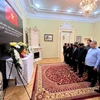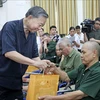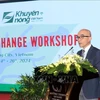The Hanoi initiative to give descriptions of the nation's most notable heroes in Vietnamese on street plaques has met with the general approval of local residents, but left foreigners befuddled.
Those behind the scheme say they hope to improve the Vietnamese people's knowledge of the nation's history.
"This change is really interesting. It helps me and other people to understand more about the country's history and educate us about the heroic traditions of our ancestors," Le Thanh Hang, a resident of Hanoi , said.
"This sign says that Le Lai is a well-known general who helped King Le Loi defeat Ming troops to protect the country in the early 15th century. I used to think he was a certain general in the anti-French resistance war," she said, pointing to the street plaque.
Nguyen Trung Hieu, an 11th grader at Nguyen Trai High School , said the appearance of these signs has attracted the attention of numerous local residents.
"People stop and read them, firstly out of curiosity, but then to learn something about history. It is easier to remember historical events walking along the street than it is to learn from a book at home. I find history quite boring," he admitted.
Dr Nguyen Thi Don, vice chairwoman of the Thang Long-Ha Noi Cultural Heritage Association and a member of the consultancy board on Hanoi's street names, said the plaques, which were erected at the start of this year, have been welcomed by locals and Vietnamese visitors to the capital.
Among those who have been immortalised on some of Hanoi's oldest streets are Le Thai To (the name Le Loi adopted when he acceded to the throne – the first king of the Le Dynasty in 1428) and Le Thach (a general who helped King Le Loi defeat Ming troops during the Lam Son uprising) . However, to ensure the information is consistent, Don said the information provided should be standardised.
But the move has caused consternation among foreign visitors who do not speak Vietnamese.
British tourist Jessica Garner approved the idea in principle but thought a description in English, as the international language, should have been included.
"It would have been better if an English translation had been included. Foreign visitors are just as interested in your nation's history and culture as Vietnamese people are, so don't forget us," she said.
Meanwhile, Nguyen Minh Duc, a student at Nguyen Trai High School , complained that the print size on the plaques is too small and so could only be read by pedestrians, not passengers in cars or pillion riders on motorbikes.
A representative from FPT Telecom, which has been charged with implementing the project, said plaques with information about national heroes will be erected on 30 streets.
He added that it will take time to fully gauge the public's response to the project. However, he said, if public opinion is favourable, the project will be extended to the whole of Hanoi .
In 2006, HCM City implemented a similar scheme that involved hanging banners on 46 streets with information about the nation's most prominent heroes, also with the aim of improving local people's historical knowledge. However, the banners were taken down when they began to fall apart. /.
Those behind the scheme say they hope to improve the Vietnamese people's knowledge of the nation's history.
"This change is really interesting. It helps me and other people to understand more about the country's history and educate us about the heroic traditions of our ancestors," Le Thanh Hang, a resident of Hanoi , said.
"This sign says that Le Lai is a well-known general who helped King Le Loi defeat Ming troops to protect the country in the early 15th century. I used to think he was a certain general in the anti-French resistance war," she said, pointing to the street plaque.
Nguyen Trung Hieu, an 11th grader at Nguyen Trai High School , said the appearance of these signs has attracted the attention of numerous local residents.
"People stop and read them, firstly out of curiosity, but then to learn something about history. It is easier to remember historical events walking along the street than it is to learn from a book at home. I find history quite boring," he admitted.
Dr Nguyen Thi Don, vice chairwoman of the Thang Long-Ha Noi Cultural Heritage Association and a member of the consultancy board on Hanoi's street names, said the plaques, which were erected at the start of this year, have been welcomed by locals and Vietnamese visitors to the capital.
Among those who have been immortalised on some of Hanoi's oldest streets are Le Thai To (the name Le Loi adopted when he acceded to the throne – the first king of the Le Dynasty in 1428) and Le Thach (a general who helped King Le Loi defeat Ming troops during the Lam Son uprising) . However, to ensure the information is consistent, Don said the information provided should be standardised.
But the move has caused consternation among foreign visitors who do not speak Vietnamese.
British tourist Jessica Garner approved the idea in principle but thought a description in English, as the international language, should have been included.
"It would have been better if an English translation had been included. Foreign visitors are just as interested in your nation's history and culture as Vietnamese people are, so don't forget us," she said.
Meanwhile, Nguyen Minh Duc, a student at Nguyen Trai High School , complained that the print size on the plaques is too small and so could only be read by pedestrians, not passengers in cars or pillion riders on motorbikes.
A representative from FPT Telecom, which has been charged with implementing the project, said plaques with information about national heroes will be erected on 30 streets.
He added that it will take time to fully gauge the public's response to the project. However, he said, if public opinion is favourable, the project will be extended to the whole of Hanoi .
In 2006, HCM City implemented a similar scheme that involved hanging banners on 46 streets with information about the nation's most prominent heroes, also with the aim of improving local people's historical knowledge. However, the banners were taken down when they began to fall apart. /.



















